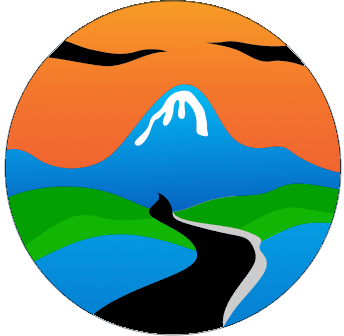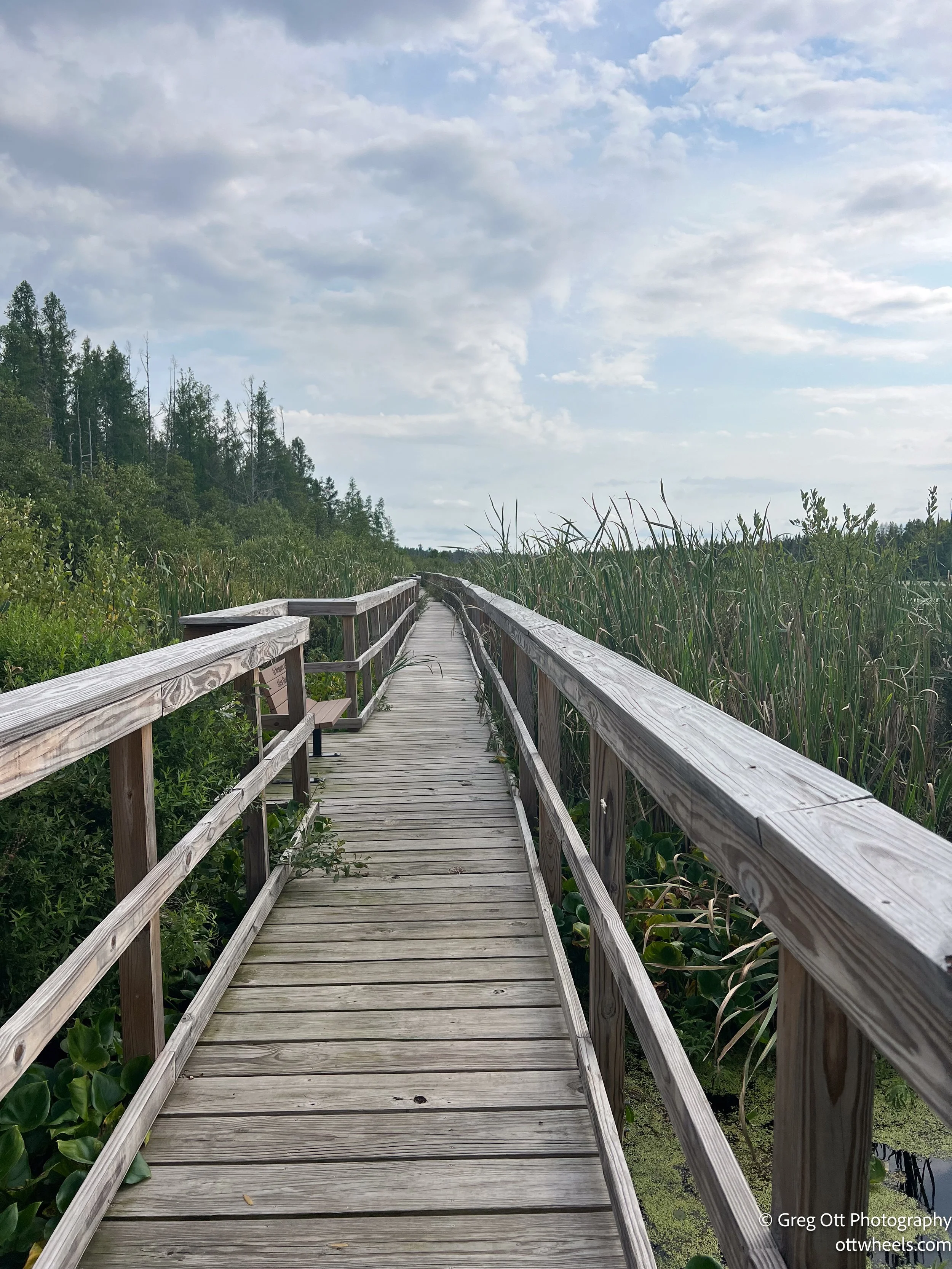Ironworld Discovery Center
I left the farm where I stayed last night and headed to Ironworld less than 2 hours away. There weren’t many cars on the road, for a Friday morning. I assumed people were taking long 3-day weekends and were out of the area already. Ironworld Discovery Center (now the Minnesota Discovery Center) opened at 10. I toured the museum for 30 minutes before the 11:00 trolley to the recreated town. The grounds are pretty spread out, so I took a little time to get from museum to trolley station.
Trolley Ride
One of the main attractions at Ironworld is the trolley ride. The bright red trolley follows a section of track that’s part of the old Mesaba Railway, which operated from 1912 to 1920. Back then, electric streetcars connected Hibbing, Chisholm, Buhl, and other towns across the Mesabi Iron Range. It was an affordable way for miners to get to work, families to shop in town, and kids to get to school. Once roads improved and cars became common, the trolley line shut down. The section at Ironworld gives visitors a chance to experience a piece of that history.
The car in use today is a restored vintage electric trolley, similar to the ones that would have run the Mesaba Railway line. Inside, it’s fitted with wooden benches, large sliding windows, and overhead handholds, keeping much of the early 20th-century look and feel.
The round trip lasts a little over an hour and is fully narrated by a guide who shares stories about the mining industry, the trolley system, and the history of the towns along the line. Along the way, the route passes old mine pits with steep red walls, reclaimed forested areas, and small wetlands that have formed in low spots where mining once took place. The narrator points out the location of the Pillsbury Mine, explains how ore was hauled to the docks on Lake Superior, and identifies several headframes and hoist houses still standing from the early mining days. In some stretches, you can clearly see the layered iron-rich soil that gave the Iron Range its name.
One stop along the route carries the Pillsbury name—a reminder that Charles A. Pillsbury, best known for the flour company that still bears his name, also had investments in Minnesota’s iron mining industry. Like many prominent businessmen of the early 1900s, Pillsbury saw opportunity in the Iron Range’s vast ore deposits and put his money into mining operations here. His involvement helped fund the extraction and shipment of ore that would feed the steel mills at the height of America’s industrial expansion.
Pillsbury wasn’t alone in branching out from his primary business into mining. Industrialists across the Midwest and East Coast—many of them tied to grain, lumber, or shipping—saw the Iron Range as a chance to diversify and profit from America’s growing demand for steel. The mining boom drew investors from all over, including banking families and manufacturing giants, all eager to claim a piece of the ore that would shape skylines and shipyards for decades.
At the halfway point, the trolley stops at a re-created early 1900s mining community. Visitors can walk through a boarding house where single miners stayed, a basic bunkhouse lined with narrow beds, and a depot with an office where tickets and freight were handled. Behind the buildings, old mining equipment is on display—ore carts, drills, and other heavy tools once used in the mines.
The Mesabi Iron Range is the largest of Minnesota’s iron ranges and one of the richest iron ore deposits in the world. Mining began here in the late 1890s, and the ore went into building railroads, skyscrapers, and ships for both World Wars. At its peak, the range supported dozens of towns and thousands of immigrant workers from Finland, Italy, Croatia, Slovenia, and other countries.
The return trip follows the same route back to the station, with more narration and more chances to spot the remnants of mining operations hidden in the trees. It’s not a fast ride, but it’s a clear look at how this area’s communities were once linked and how mining shaped both the land and the people who lived here.
Exploring the Museum
After the trolley ride, I spent about two hours in the museum. It covers not just the mining itself, but the communities and cultures that developed around the Mesabi Iron Range.
One of the more surprising displays was an old loom, purchased jointly by six families. Each family paid a share, and the loom was rotated between households. It wasn’t something you could just carry down the street—when it was time for the next family to use it, the loom had to be taken apart, moved, and set up again. It was used to weave cloth for clothing, blankets, and other essentials. In the early days, with few stores and limited cash, this kind of shared resource was common in immigrant communities.
The mining exhibits gave a blunt look at working conditions underground. Shifts often ran 10–12 hours, six days a week, and miners were paid by the ton for the ore they extracted—not for the time they worked. That meant hours spent digging through rock to reach an ore vein or building timber supports didn’t earn anything directly. Bribes to foremen were common—paying for a better section of the mine with richer ore. Even with safety measures, about 100 miners died every year from cave-ins, equipment accidents, and other hazards.
The museum also covered life outside the mines. Many towns on the Iron Range had a lot of saloons—dozens of them in some places. It wasn’t unusual for a small mining town to have 60 or 70 saloons (red buildings below), often catering to specific language or ethnic groups so people could socialize in their native tongue. Drinking was a big part of social life but also a serious problem. Pay could disappear over the bar in a weekend. Disorderly conduct arrests were common, and getting arrested often meant losing your job. Drunkenness hurt productivity and caused safety risks in the mines.
Prohibition, which lasted from 1920 to 1933, hit these towns hard. It was a nationwide ban on the production, sale, and transport of alcoholic beverages. While intended to reduce alcohol abuse, it fueled a rise in illegal bars (“speakeasies”), bootlegging, and organized crime. In mining towns, the closure of legal saloons disrupted a major social hub, but it didn’t stop drinking—it just pushed it underground. Enforcement was inconsistent, and some mining communities were known for openly ignoring the law.
The labor history section dug into strikes and labor disputes that shaped the Iron Range. Workers often pushed for better pay, shorter hours, and safer conditions. Strikes were met with brutal resistance from mining companies—hired guards, strikebreakers, and sometimes armed confrontations. Over time, local unions formed and eventually became part of national organizations like the United Steelworkers. The exhibits also touched on “right-to-work” laws. While the name sounds pro-worker, these laws often weakened unions by allowing workers to opt out of paying union dues while still receiving union benefits, making it harder for unions to fund organizing and bargaining efforts.
The museum pulled no punches—life on the Iron Range wasn’t easy. The exhibits balanced the technical side of mining with the human stories of the people who made their lives here.
Ironman
I left the Ironworld Discovery Center and, just outside the exit, came upon a massive, awe‑inspiring statue titled “The Emergence of Man Through Steel”, commonly known as the Iron Man. Towering 85 feet above a base of rust‑red steel girders, the colossal figure of a weary iron‐ore miner, helmet aglow, stands as a solemn tribute to the men who forged the Iron Ranges—an emblem of grit and the industrial backbone of America.
Orr Bog Walk
The Orr Bog Walk is a short, winding boardwalk through what looks at first glance like just another patch of Minnesota forest—until you step onto it and realize the ground is something entirely different. A plaque near the entrance explained that a bog is a wetland with almost no mineral content in its soil or water. Rain and snowmelt feed it, but because there’s no stream or river to bring in fresh minerals, the ecosystem is perpetually starved of nutrients. That lack is so extreme that many familiar plants simply can’t survive here. True bogs are actually rare in the United States, found mostly in northern states like Minnesota, Michigan, Wisconsin, and Maine, plus parts of Alaska. In much of the country, they don’t exist at all. I’ve included images of the information boards from the park.
Still, a bog can appear surprisingly lush. The plants here are specialists—survival experts that have evolved to thrive in harsh conditions. Sphagnum moss, sedges, low shrubs, and even trees like black spruce and tamarack (a deciduous conifer) have adaptations that let them live in acidic, nutrient-poor soils. These trees keep their roots shallow, growing slowly over decades, which explains why bog “forests” often look oddly stunted. Carnivorous plants like pitcher plants and sundews take a different approach, trapping insects to supplement their meager diet.
In Europe, similar bogs have an even stranger story to tell. The acidic, oxygen-poor water in those wetlands can preserve human bodies for over a thousand years, a fact that’s as fascinating as it is eerie. The plaque didn’t shy away from this, noting how these “bog bodies” still retain hair, skin, and even clothing long after burial.
Along the Orr boardwalk, there was a small patch of cattails—the only spot where the soil held enough nutrients to support them. It stood out because everywhere else was a tapestry of moss, sedges, and low shrubs. The abundance of greenery can make it hard to believe the place is nutrient-poor, but the reality is that these plants are simply better at making do with less.
As for flowers or splashes of color—summer isn’t necessarily the bog’s showiest season. Apparently, spring is when many of the blooms appear, taking advantage of the brief period before the moss dries out and the insect population peaks (there were plenty of mosquitos). By midsummer, most flowering plants have already gone to seed, leaving behind a quieter, more subdued landscape. The real interest at this time of year comes from the textures and shades of green, the occasional insectivorous plant, and the thought that beneath all this life, the bog is still an ancient, slow-growing world.
Harvest Host
I headed 30 minutes south to Cook, MN, to fill up on gas and grab some groceries. My Harvest Hosts stop for the night was at a small airport built in 1938, but Google Maps had other plans. It tweaked the address just enough to send me on a scenic—if unplanned—tour of town. After a couple of wrong turns and one unexpected detour to the airport (the wrong one), I finally gave up on addresses, plugged in the GPS coordinates, and got myself back on track.
When I arrived, Pat greeted me with a plate of homemade cookies and a spaghetti squash. Dave joined us later, and we chatted for an hour before they showed me where to park. Pat helped me get leveled, warning me about the heavy rain on the way. That night, the storm rolled in hard—lightning flashing so often it turned my fan vent into a strobe light.




























